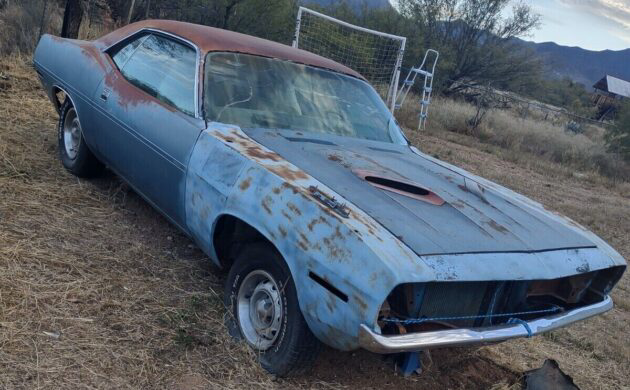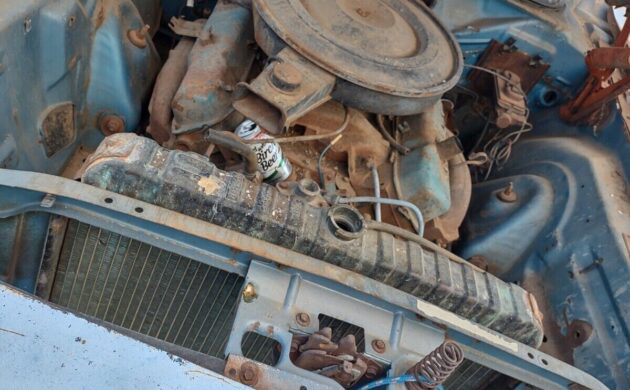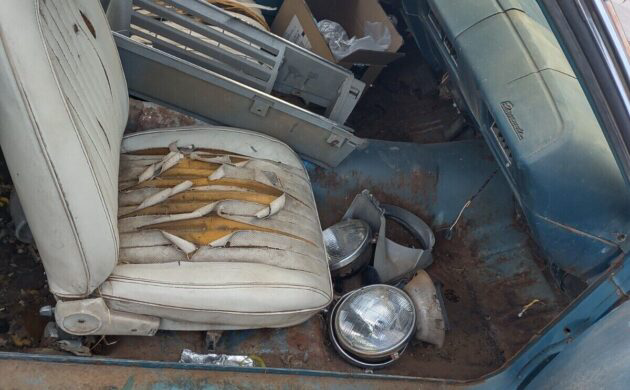In 1964, Plymouth introduced its first pony car, the Barracuda. Situated on Chrysler’s compact A-platform, its fastback styling was actually a Valiant in disguise. The first cars even carried Valiant badging, shifting to the fish in 1965 as Plymouth attempted to shed the frugal family car image. As the model evolved, the car finally received a blank-page re-design in 1967. By 1970, American car makers were pursuing the “bigger is better” grail, and the Barracuda was moved to the larger E-platform. Here on eBay is a 1970 Plymouth Barracuda looking for a new home, bid to $9,999 with reserve not met and an $18,500 buy-it-now price. It is currently located in Hot Springs Village, Arkansas. The car does not run and has extensive rust, as we’ll see. The original colors were blue over white, and all the tags are present. Decoding the VIN shows its motor was a 383 cu. in. V8 with a two-barrel carburetor.
The motor may or may not be original to the car, and the seller says he’s not going to help you figure that out. Whatever motor it is, it’s frozen. The 383 was offered with two different carburetors: the two-barrel generated about 300 bhp and was paired with a three-speed TorqueFlight automatic (factory for this VIN), or you could opt for the four-barrel with 330 bhp and several transmission options. Larger engines included the 426 cu. in. hemi and the 440. By the time 1970 rolled around, Barracudas were showing up on tracks all over the country.
Several trim levels were available in 1970. These included the Barracuda, Barracuda Gran Coupe, and the ‘Cuda, but realistically each level could be optioned almost any way. Obviously, this car needs an interior, along with almost everything else. The trunk is a mother lode of parts, some of which may actually be usable. The grille is with the car but damaged. The windshield is cracked; other glass is at least present.
Rust has invaded almost all the panels and rails. The seller says the hood, quarters, at least one frame rail, floor pans, and several other areas are compromised. Poor repairs were attempted on both front fenders which probably makes them unusable. Meanwhile, restored 1970 Barracudas are seeing $90,000 asking prices, leaving some scope for tackling this one, so long as you are handy with a welder. Is the glass half empty here, or half full? This car is either Scraptopia, or it’s Cinderella – what do you think?






For me the answer to this vehicles worth, is whether it’s matching numbers motor and tranny. If it is, with how popular and rare these are becoming, it’s going to take a lot of time, money and effort to get rid of the rust but you got a one thousand dollar car plus if done right. And they are going to continue to rise in value!! If it’s not matching numbers which is what I tend to believe by the owners attitude, it’s probably worth it but not nearly as exciting. The rust is bad without a doubt but it always is once it gets into these e bodies. The rust present shows me it probably spent a lot of time in a field with the grass and weeds growing up around it and underneath. Cut out the rust, replace it fix her up. But do that in person inspection to see if she is numbers matching! That’s for sure!!!
It’s reasonable to assume that there are a lot of things about this car that aren’t original (the seats aren’t — per the fender tag, the door trim panels, and the dash pad the car was “born” with a blue interior), so a non-numbers matching drivetrain wouldn’t be a huge surprise. That said, even a numbers matching 383 2 barrel isn’t going to create much excitement. Quite frankly, a base model E-body was a much better driver with a 318 under the hood.
The most unique thing about this car, as far as I can tell, is that it was built in Los Angeles, while the vast majority of 1970 E-bodies were built at Hamtramck. Most of the relatively few Los Angeles-built E-bodies were shipped to west coast destinations, so this one likely spent a number of years migrating inland, probably in the hands of a number of owners, prior to settling in Arkansas.
I don’t think you meant “a thousand dollar car”
I’m might be interested….as long as the Swing Set comes with it ! lol
It doesn’t appear to be ultra rusty,
Either sold at $10,099 or was pulled early. Either way it was a very rusty car that the average gear head could not afford to fix and enjoy unless they had been saving it since the 90s when they bought it at a reasonable price. That frame scale looked rough. Looks like the frame of my old salt truck. Definitely a job for an investor.
Have not had a birch beer soda in like 40 years.
Looking at the photos from this one it is definitely not worth salvaging unless for a parts car. Too far gone.